Thursday, August 07, 2025
Irish Conflict in Comics by James Bacon
There are very few studies of historical events as they are portrayed through comics. An introduction may tackle the origins of individual characters, but generally speaking books about comics are usually about the comics themselves (histories of individual titles or broader histories by Denis Gifford, Paul Gravett or David Roach) and subjects (the war and football comics covered by Adam Riches).
James Bacon's book hones in on the story of Irish conflicts through the ages, dating back to historical depictions of Ireland: the era of Arthurian legend in Prince Valiant and the 15th century in Kevin the Bold; he finds dozens of Irish characters in war books and weeklies; through to stories set in The Troubles in the pages of Crisis; and the continuing depiction in the 21st century.
The intention of the book is to shine a light on a vast number of stories that have remained hidden by simply being buried under the thousands of others that have appeared over years, some of them obscure titles previously only found in lists such as Island of Hate in Battleground (#14, 1964) or A Bit of the Irish in Combat Picture Library (#524, 1972).
Being interested in British comics, these are the entries that I gravitated to, firstly to Charley's War where correspondence reveals how Pat Mills had intended to continue the epic of Charley's family by featuring Charley's son in World War Two and his grandson in Northern Ireland (don't forget, Pat's mother was Irish). But these are stories that were never written.
Introducing a section that covers many war libraries of the 1960s, James notes that "even when an Irish character is portrayed as a bruiser, or cheat, they often redeem themselves, because this is either seen as 'clever', using initiative or deploying a dynamic approach which wins out ... the Irish 'strength' of being a doughty fighter is of course played up and allows for antagonism and positive aggression against the enemy, the Germans." This treatment may stem from having stories written by real-life veterans of the war—scriptwriters for Fleetway and DC Thomson fought in all three services in some of the War's greatest battles—and was at odds with the "no dogs, no blacks, no Irish" attitude of some, and the boorish depiction of the Irish as thick by comedians.
Some surprises include the likes of Come Home, Kathleen in Bunty (1977-78), in which a mistreated Irish lass is worked hard by an English family with airs and graces above their means, and then evacuated (due to the war) to the clutches of Miss Jardine, who maltreats her even more. The Fifth Swan Child (Judy, 1981) sees a troupe of child performers trapped in France just as the Germans invade and James's summation ("the bleakness and tragic end, I was stunned") makes me wish it was available as a reprint.
This is a thoroughly researched book, not just of British comics but also American comics dating back to the war years. There are, of course, mentions of Irish writers such as Stephen Walsh (Commando) and Garth Ennis (everywhere!) who have tried to tackle Irish conflicts in their work. You'll also find entries for a fair few French, Dutch and Italian comics.
James Bacon packs an awful lot into 260 A4 pages. While the subject matter may seem focused and maybe not your cup of tea, there's a lot of contextual material about how war and conflict is portrayed in comics and its likely that one of your favourites, be it Hellblazer or Daredevil, will have a sneaky Irish connection you've forgotten about.
Irish Conflict in Comics by James Bacon
Limit Break Comics ISBN 978-106841973-7, August 2025, 260pp, £12.99 [$15.00]. Available via Amazon.
Labels:
Review
Subscribe to:
Post Comments (Atom)



























































No comments:
Post a Comment